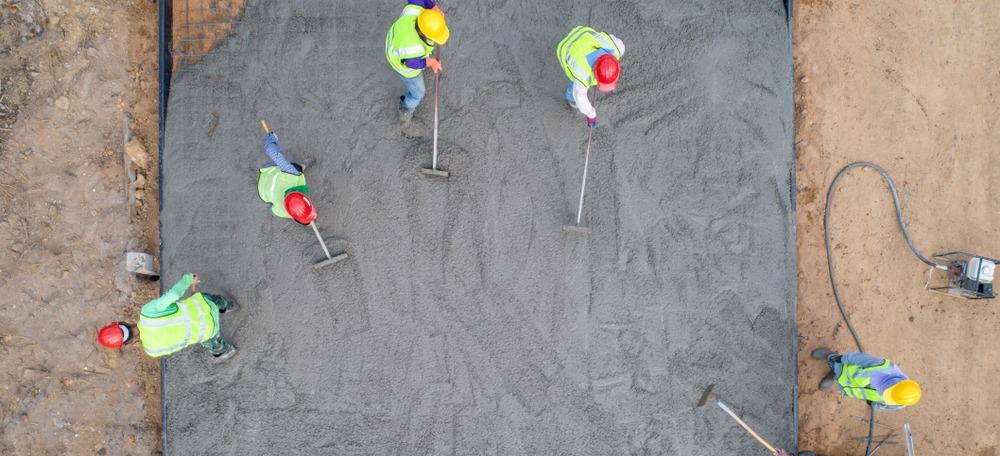With the growing desire of reducing carbon footprint, recent research projects have aimed to use graphene for real-world deployment in concrete manufacturing. This world-first graphene solution could reduce the extensive effect concrete has on carbon footprint with a novel concrete manufacturing process leading to the formation of ‘Concretene’.

The University of Manchester and Nationwide Engineering have developed graphene technology that will revolutionize the building sector. Image Credit: Bannafarsai_Stock/Shutterstock.com
The novel graphene solution aims to enhance streets in the UK, starting with the formation of a new gym. This article will explore the eco-friendly research belonging to scientists at the University of Manchester and construction firm Nationwide Engineering, and how graphene, as the world’s strongest artificial material, has the potential to revolutionize the building industry.
Graphene, an allotrope of carbon, is the thinnest layer of graphite possible and is made up of a monolayer of carbon atoms within a hexagonal lattice shape. The benefits of using graphene consist of it being a thin, flexible material that is stronger than steel. The use of graphene is being more widely researched for use in advanced applications such as electronics, semiconductors, and the concrete manufacturing process.
The Concrete Manufacturing Process
The use of graphene within concrete manufacturing would be the world’s first graphene solution to create Concretene.
Scientists from the University of Manchester and the construction team at Nationwide Engineering have worked together to take this idea and bring it to fruition.
The concept relies on forming the material by adding tiny amounts of graphene to water and cement. This allows the novel material to act as a mechanical support and also provides an extra catalyst surface for chemical reactions which help create the concrete mixture. This process results in the novel Concretene solution which has better bonding at a microscopic level as well as higher strength by 30% compared to traditional concrete.
This novel material was used for the initial concrete floor slab for the new Southern Quarter gym based near Stonehenge in the UK. This marks the world’s first graphene-concrete slab created and used for manufacturing a building as well as a world-first graphene solution.
Dr Craig Dawson from The University of Manchester states that this graphene-based additive mixture “is non-disruptive at the point of use. That means we can dose our additive directly at the batching plant where the concrete is being produced as part of their existing system, so there’s no change to production or to the construction guys laying the floor."
This lack of significant change to the process would make it easier for mass use as it would not be difficult to switch between the traditional concrete manufacturing process to include the world’s strongest artificial material for structural advancement.
Environmental Benefits for the Industry
Concrete production carries high global carbon emissions, and so a graphene-enhanced concrete solution would be a welcomed advancement to reduce carbon emissions worldwide.
The production of concrete accounts for 8% of global carbon emissions and stands so high, it would be third in line for carbon emission production after China and USA if it were a country.
Nationwide Engineering, which is rooted in the building industry, retains contracts with Network Rail as well as the Government Crown for building frameworks. With the HS2 high-speed rail project expected to use 19.7 million tons of concrete, this will result in approximately 5 million tons of carbon dioxide and 1.4% of UK CO2 emissions. The addition of lorries and trains that carry the material also adds to the environmental impact.
Due to the high strength of Concretene in comparison to normal concrete, it can be used in smaller volumes for the same result of structural strength as normal concrete. This would significantly reduce the carbon footprint and cost of concrete production.
As confirmed by Nationwide Engineering, the universal use of Concretene would bring global emissions down by 2% and create a more eco-friendly lifestyle.
Alex McDermott, co-founder of Nationwide Engineering commented on how thrilled the company was with using “this game-changing, graphene-enhanced concrete on a real project,” adding that, “together with our partners at The University of Manchester’s Graphene Engineering Innovation Centre and structural engineers HBPW Consulting, we are rapidly evolving our knowledge and experience and are positioned for wider industry deployment through our construction frameworks, becoming the go-to company for graphene-enhanced concrete.”
The world-class impact of both the University of Manchester as well as Nationwide Engineering with the use of the world’s strongest artificial material within concrete will be revolutionary for the building industry.
By using this novel material for real-world projects, global emissions can be reduced while driving the advancement of building manufacturing.
Further Reading and References
Nationwide Engineering. 2021. [Online] Available at: https://nationwideengineering.co.uk/ [Accessed 9 June 2021].
New Atlas. 2021. World's first graphene-enhanced concrete slab poured in England. [Online] Available at: https://newatlas.com/materials/worlds-first-graphene-enhanced-concrete-slab/ [Accessed 9 June 2021].
D. Ghuge, A., R. Shirode, A. and J. Kadam, V., 2017. Graphene: A Comprehensive Review. Current Drug Targets, 18(6), pp.724-733. https://doi.org/10.2174/1389450117666160709023425
Disclaimer: The views expressed here are those of the author expressed in their private capacity and do not necessarily represent the views of AZoM.com Limited T/A AZoNetwork the owner and operator of this website. This disclaimer forms part of the Terms and conditions of use of this website.